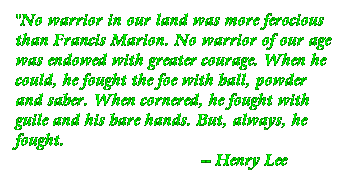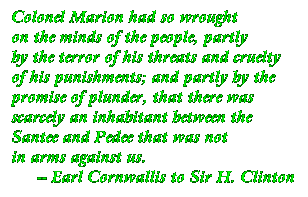


| [ Previous ] [ Next ] |

|

|
The most famous rebel partisan leader of the Southern Campaign, the legendary "Swamp Fox," was a planter and Indian fighter before the war, and joined the Moultrie's regiment just prior to the outbreak of the rebellion. Marion fought with Lincoln at Savannah, but was on sick leave when Charleston was besieged. After Camden, he began a campaign of guerilla warfare that disrupted Cornwallis's communications and supply lines, as well as taking out scouts and foraging parties. What he lacked in men and arms, he made up for with resourcefulness.
Marion's credentials as a hero have gotten rather tarnished thanks to modern research -- even the producers of The Patriot felt compelled to change their focal character's name to "Martin" after looking into Marion's background -- but his effectiveness as a partisan leader cannot be denied. His methods were far from clean, and on occasion he was reputed to be more brutal than the worst accusations ever laid against Tarleton. As an example, a British military report claims that a slave named Harry, who served as a spy for Lord Rawdon and Balfour, had the misfortune to fall into the hands of Marion's partisans "by whom He was beheaded & his head set upon a Stake, when Genl. Gould's Army passed the Greenland Swamp." (Such treatment had certainly been used previously by the rebel army to terrorize Loyalists, and not simply by the irregulars. In January, 1781, Otho Holland Williams, a senior Continental officer, gleefully reported to Daniel Morgan that a "Major Gray" had "lost his mulatto Head. It is exhibited at Cheraw Hill, a terror to Tories.")1
On the other hand, Marion once complained to General Nathanael Greene that bandits and outlaws ("Skinners") committed atrocities and claimed they were "Marion's Men" so it is difficult to get a feel for which activities were his and which may have been done by others, under the cloak of his growing mystique.2

|
Balancing off against his wartime tactics, Marion is also remembered for speaking out against anti-Tory retributions after the war and attempting to heal wounds among neighbors.
As the Swamp Fox, Marion must be the center of more urban legends than any other man in the war except George Washington. Marion and Ban played tag through the swamps on numerous occasions, with the games going quite definitely to Marion. (Hardly surprising, given the enormity of the home ground advantage. Later wars, from Vietnam to Afghanistan, have proved the same points about guerrillas vs regulars over and over again.) According to legend, Banastre provided Marion with his nickname, "The Swamp Fox," on one of the occasions when he chased Marion's tail into the middle of nowhere, only to lose him.
I haven't specifically looked into the matter, but I gather no contemporary portraits of Marion exist. There are several engravings around, such as the one on this page, which are presumably based on verbal descriptions or earlier sketches which are now lost. Charles Flood offers this entertaining description of the Swamp Fox, along with the assessment of one of Marion's comrades-in-arms:
"Short, with piercing black eyes and a pugnacious chin, he had a reputation as a severe disciplinarian as well as a fighter. A lieutenant who served with him at Charleston summed him up this way: 'An ugly, cross, knock-kneed, hooknosed son of a bitch.'"3

|
| [ Index ] | [ Previous ] [ Next ] |
1 Otho Holland Williams to Daniel Morgan, 25 January 1781, in Theodorus Bailey Myers, ed. Cowpens Papers: Being Correspondence of General Morgan and the Prominent Actors (Charleston, 1881), p33. [ back ]
2 A transcription of this letter can be found on the Online Institute for Advanced Loyalist Studies website, see links. [ back ]
3 Charles Bracelen Flood, Rise, and Fight Again; Perilous Times Along the Road to Independence (New York: Dodd, Mead & Company, 1976), p285. [ back ]
| Return to the Main Page | Last updated by the Webmaster on January 30, 2004 |